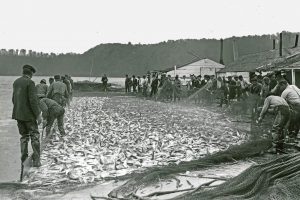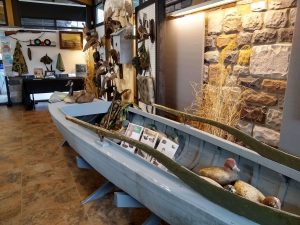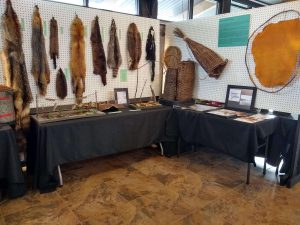A Look Back at Hunting, Fishing & Trapping
A Look Back at Hunting, Fishing, & Trapping on the Susquehanna River
Susquehanna National Heritage Area and local historian Lynn Smoker present A Look Back at Hunting, Fishing & Trapping on the Susquehanna River, now on display at Columbia Crossing River Trails Center. The exhibit provides a glimpse into the techniques and tools for capturing wildlife on the Lower Susquehanna River. Smoker has spent years enjoying the river as an avid hunter and fisherman and as a devoted collector of Susquehanna River artifacts. Visitors to this brand-new exhibit will see original and unique tools and artifacts related to hunting, fishing, and trapping, including a locally built duck boat from 1927, along with an array of mounted waterfowl, fish, and furbearing mammals.
Hunting has played a rich and prominent role in American culture. For centuries, hunting was required for survival. Native Americans utilized the animals in and along the river not just to feed their families but for heat, clothing, and shelter. Pioneers settled the region and harvested game as readily as they planted crops. Although the Lower Susquehanna River region transitioned to farming livestock, the hunting tradition stayed ingrained in the culture. These traditions continue to connect people to the raw beauty of the river and all the resources it provides.
 The Susquehanna River has remained a sanctuary for a variety of wildlife as it is naturally non-navigable to industrial vessels. Prior to the construction of hydroelectric dams, the Susquehanna River had a rush of migratory fish each spring. Shad swelled up the river sometimes looking like waves in the water. Locals plucked them from the river by the hundreds. Learn about the shad runs, ice fishing, and fishing techniques of generations past.
The Susquehanna River has remained a sanctuary for a variety of wildlife as it is naturally non-navigable to industrial vessels. Prior to the construction of hydroelectric dams, the Susquehanna River had a rush of migratory fish each spring. Shad swelled up the river sometimes looking like waves in the water. Locals plucked them from the river by the hundreds. Learn about the shad runs, ice fishing, and fishing techniques of generations past.
 The Susquehanna River is an integral part of the Atlantic Flyway, one of four major North American migratory routes for waterfowl. Pennsylvania hunters annually take good numbers of mallards, wood ducks, and black ducks. Many also experience good action for buffleheads, bluebills, ring-necks, green-winged teal, Canada goose, and snow geese. Hunters typically decoy, blind hunt, or pass-shoot from open water or on nearby agricultural fields. Learn about the unique design of the Susquehanna River waterfowl decoys and how they have become a celebrated American folk-art tradition.
The Susquehanna River is an integral part of the Atlantic Flyway, one of four major North American migratory routes for waterfowl. Pennsylvania hunters annually take good numbers of mallards, wood ducks, and black ducks. Many also experience good action for buffleheads, bluebills, ring-necks, green-winged teal, Canada goose, and snow geese. Hunters typically decoy, blind hunt, or pass-shoot from open water or on nearby agricultural fields. Learn about the unique design of the Susquehanna River waterfowl decoys and how they have become a celebrated American folk-art tradition.
 Furbearing animals like beaver, river otter, marten, and mink were essential to Native Americans especially in trade with Europeans. See these furs and learn about how they were trapped and traded by the Susquehannock, the only native tribe to trade with all four major European colonialists (Dutch, Swede, English and French). For over two centuries, beaver fur was especially desirable for men’s hats. Trapping continues to be a riverfront tradition but is highly regulated as a wildlife management strategy. Modern techniques, sanctioned seasons, and permitting have contributed to the repopulation of beaver and river otter along the Susquehanna River.
Furbearing animals like beaver, river otter, marten, and mink were essential to Native Americans especially in trade with Europeans. See these furs and learn about how they were trapped and traded by the Susquehannock, the only native tribe to trade with all four major European colonialists (Dutch, Swede, English and French). For over two centuries, beaver fur was especially desirable for men’s hats. Trapping continues to be a riverfront tradition but is highly regulated as a wildlife management strategy. Modern techniques, sanctioned seasons, and permitting have contributed to the repopulation of beaver and river otter along the Susquehanna River.
The exhibit also explores hunting for bullfrogs and snapper turtle. Hunters utilized kerosene lights and gigs to bag frogs in the darkness. Snappers were more difficult and dangerous – with a bite that could remove a human finger. Antique snapper traps, gigs, and even recipes are on display.
A Look Back at Hunting, Fishing & Trapping on the Susquehanna River will be on display at Columbia Crossing River Trails Center through August 2021. A series of outdoor, social-distanced lectures are being planned for the spring/summer 2021 to more deeply explore the history surrounding these traditions. Visitors are welcome to come during operating hours: 10 am – 4 pm Tuesday through Saturday and 12 pm – 4 pm on Sundays. Exhibit is free but donations are appreciated.
